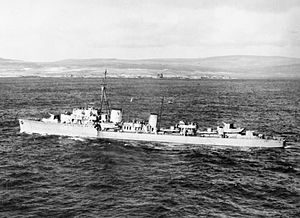Gerard Callenburgh-class destroyer
This article includes a list of references, related reading, or external links, but its sources remain unclear because it lacks inline citations. (January 2013) |
 Isaac Sweers, underway in 1942
| |
| Class overview | |
|---|---|
| Name | Gerard Callenburgh class |
| Operators | |
| Preceded by | Admiralen class |
| Succeeded by | Holland class |
| Built | 1937–1940 |
| In commission | 1941–1944 |
| Planned | 4 |
| Completed | 2 |
| Lost | 2 |
| General characteristics as designed (see text) | |
| Type | Destroyer |
| Displacement |
|
| Length | 107 m (351 ft 1 in) |
| Beam | 10.6 m (34 ft 9 in) |
| Draft | 2.8 m (9 ft 2 in) |
| Propulsion |
|
| Speed | 37.5 knots (69.5 km/h; 43.2 mph) |
| Range | 3,200 nmi (5,900 km; 3,700 mi) at 15 kn (28 km/h; 17 mph) |
| Complement | 158 |
| Armament |
|
The Gerard Callenburgh class were a group of four destroyers ordered for the Royal Netherlands Navy just before World War II. Two ships were completed - Gerard Callenburgh by the Germans after being captured and Isaac Sweers in Britain after being evacuated as the Netherlands fell to the Nazis.
Design
[edit]
These ships were larger than the preceding Admiralen-class destroyers. As those ships were outclassed by contemporary Japanese destroyers, the armament was increased to 5 guns with twin mounts in 'A' and 'Y' positions and a single gun in 'X' position. The torpedo outfit was also increased to two quadruple tubes. Isaac Sweers was completed in a British yard, with British armament and fire control equipment. She was fitted out with six 4-inch guns arranged in double turrets, four 40 mm Bofors and eight 0.5 in machine guns, as well as the customary eight torpedo tubes.
Service
[edit]Only two ships were ever completed. Tjerk Hiddes was launched prior to the invasion, but was scuttled at Rotterdam to prevent her from falling into German hands. The Germans raised her, but found it impossible to repair her, so the wreckage was scrapped. Philips Van Almonde was demolished on the slipway after several attempts to launch her to be sailed to England had failed.
Gerard Callenburgh was also scuttled, but the Germans were able to salvage her. She was subsequently completed by Blohm & Voss, retaining most of the Dutch armament and equipment, and was commissioned as ZH1 on 11 October 1942. She spent most of her career on trials in the Baltic but was transferred to Western France via the English Channel in November 1943. She was one of the German ships sent to intercept the Operation Neptune invasion armada, but they were themselves engaged by a squadron consisting of Tartar, Ashanti, Eskimo, Javelin, Haida, Huron and Błyskawica). ZH1 was torpedoed and badly damaged by Ashanti on 9 June 1944, and was scuttled with the loss of 33 men.
Isaac Sweers was, unlike her sister Philips Van Almonde, launched and then towed to England by the tug Zwarte Zee. She was completed in England by John I. Thornycroft & Company using British armament and fire control equipment. She went on to serve in the Mediterranean Sea with Force H. In December 1941, together with Sikh, Maori and Legion she sank the Italian cruisers Alberico da Barbiano and Alberto di Giussano in the Battle of Cape Bon. She then briefly served in the Indian Ocean with the Eastern Fleet. She was sunk by U-431, commanded by Wilhelm Dommes on 13 November 1942, in the Western Mediterranean, with the loss of 108 men.
Ships
[edit]| Name | Builder | Laid down | Launched | Commissioned | Fate |
|---|---|---|---|---|---|
| Gerard Callenburgh | RDM Rotterdam | 12 October 1938 | 12 October 1939 | 11 October 1942 | Scuttled but salvaged; Commissioned as the German ZH1; Sunk, 9 June 1944 |
| Isaac Sweers | KM de Schelde | 26 November 1938 | 16 March 1940 | 29 May 1941 | Towed to England and completed; Sunk, 13 November 1942 |
| Tjerk Hiddes | RDM Rotterdam | 1 October 1938 | 12 October 1939 | — | Scuttled, 15 May 1940; Wreck scrapped by Germany |
| Philips van Almonde | KM de Schelde | 2 March 1939 | — | — | Demolished on the slipway; 17 May 1940; Wreck scrapped by Germany |
Citations
[edit]General references
[edit]- M. J. Whitley, Destroyers of World War 2, 1988 Cassell Publishing ISBN 1-85409-521-8
- Page on Callenburgh from Uboat.net
- Page on Isaac Sweers from Uboat.net
- Page on Isaac Sweers from the Dutch Navy
- Page from Dutch Destroyers Archived 2020-11-16 at the Wayback Machine
- Technical page from the Dutch navy
